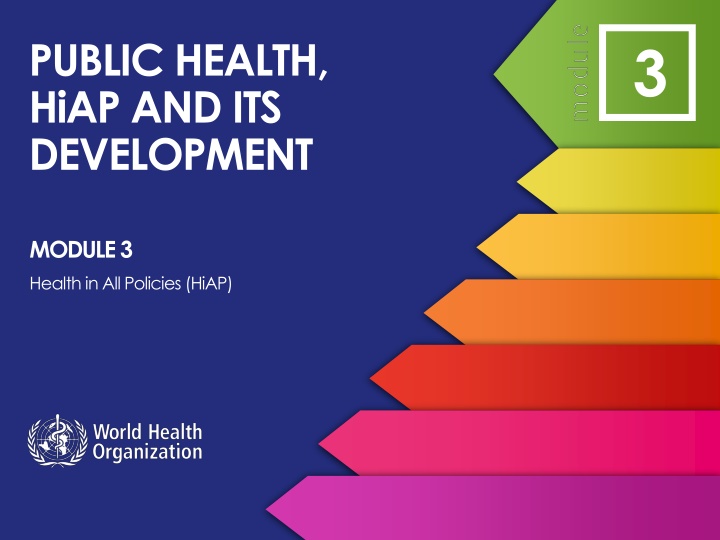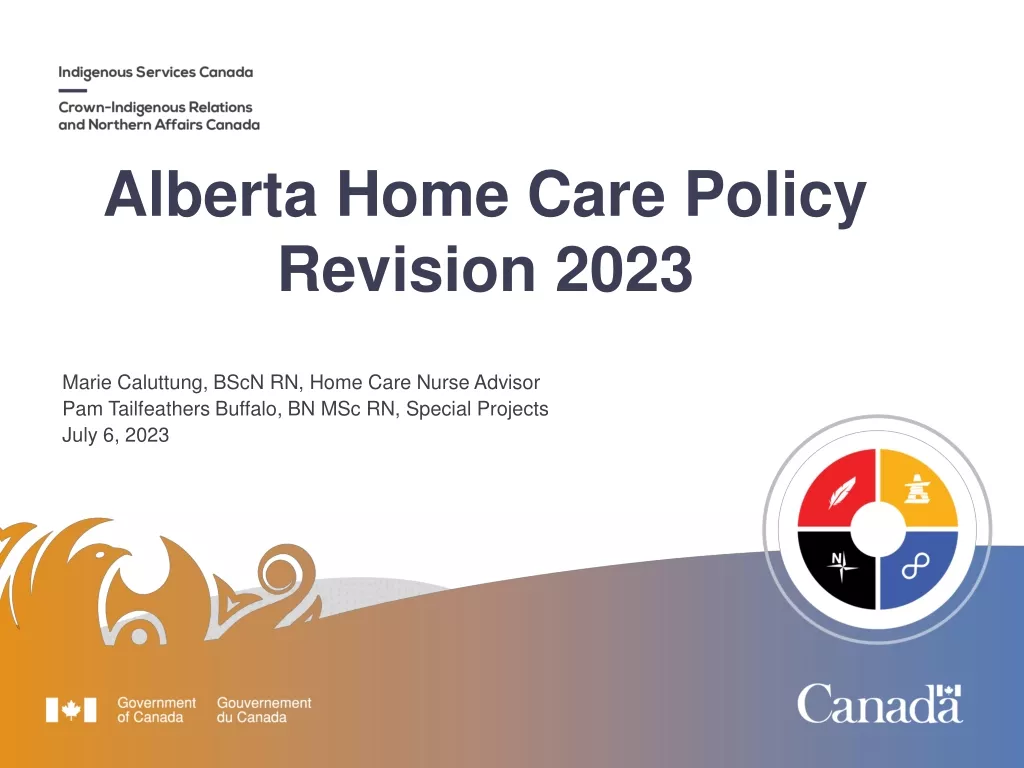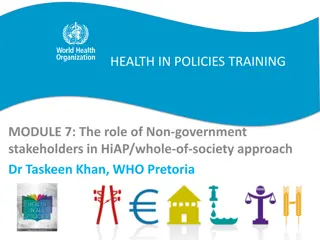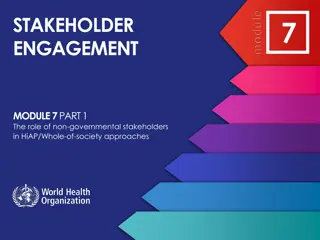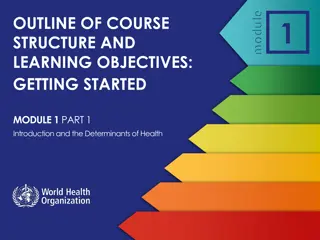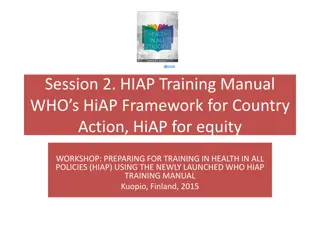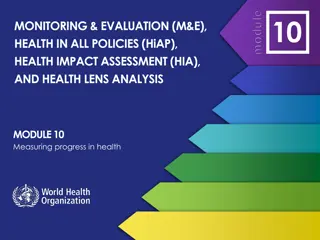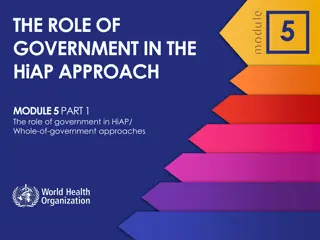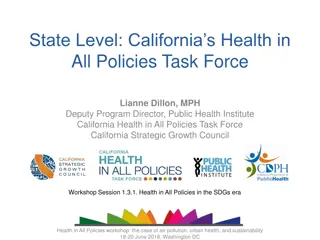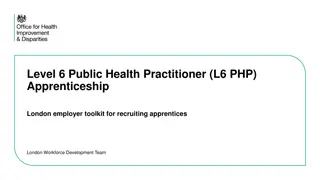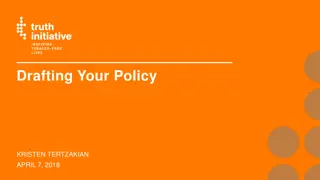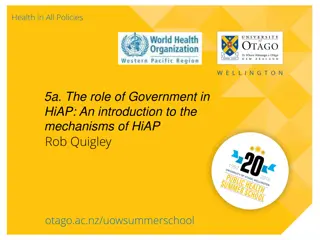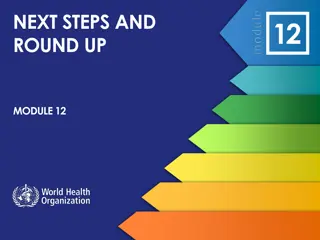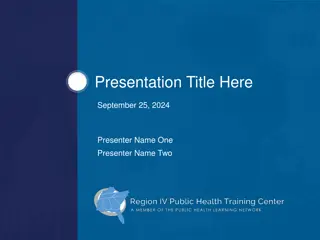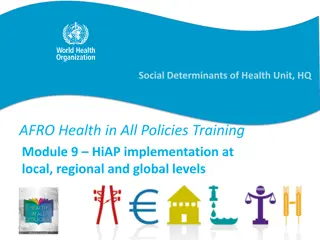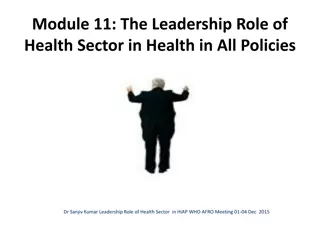Public Health and HiAP Development: Understanding Health in Policies
Public health encompasses organized efforts to prevent disease and promote community well-being. Health in All Policies (HiAP) is an approach that considers health implications in decision-making across sectors to enhance population health and equity. Learn about the origins of HiAP, when to apply it, and its distinction from other policies.
Uploaded on Mar 13, 2025 | 2 Views
Download Presentation

Please find below an Image/Link to download the presentation.
The content on the website is provided AS IS for your information and personal use only. It may not be sold, licensed, or shared on other websites without obtaining consent from the author.If you encounter any issues during the download, it is possible that the publisher has removed the file from their server.
You are allowed to download the files provided on this website for personal or commercial use, subject to the condition that they are used lawfully. All files are the property of their respective owners.
The content on the website is provided AS IS for your information and personal use only. It may not be sold, licensed, or shared on other websites without obtaining consent from the author.
E N D
Presentation Transcript
PUBLIC HEALTH, HiAP AND ITS DEVELOPMENT 3 MODULE 3 Health in All Policies (HiAP)
LEARNING OBJECTIVES 3 1 Define public health and HiAP Explain the origins and development of HiAP 2 Recognize when to use a HiAP approach 3 Distinguish the HiAP approach from other public policies 4
3 PUBLIC HEALTH DEFINITION Public health refers to all organized efforts to prevent disease, promote health and prolong life among the population as a whole. Its activities aim to provide conditions in which people can be healthy and focus on entire populations, not on individual patients or diseases. Public health is concerned with the total system and not only the eradication of a particular disease.
PUBLIC HEALTH FUNCTIONS 3 THE THREE MAIN PUBLIC HEALTH FUNCTIONS ARE: Assessment monitor health; assess the population and investigate Policy development inform, educate, empower; mobilize partnerships; develop polices Assurance enforce laws; link to/provide care; assure competent workforce; evaluate.
DEFINITION OF HEALTH IN ALL POLICIES (HiAP) 3 HiAP is an approach to public policies across sectors that systematically takes into account the health implications of decisions, seeks synergies and avoids harmful health impacts in order to improve population health and health equity. WHO (2013) Helsinki Statement on Health in All Policies. WHO 8th Global Conference on Health Promotion.
POLICY SITUATIONS THAT FAVOUR A HiAP APPROACH 3 COMPLEX HEALTH CHALLENGES EXTERNAL POLICIES WITH HIGH IMPACT ON HEALTH GOVERNMENT PRIORITY AFFECTING MANY SECTORS Source: diagram developed by authors from analysis in Leppo K et al. (2013) Health in All Policies: Seizing opportunities, implementing policies. Finland, Ministry of Social Affairs and Health, p. 329.
PRIORITIZING OF ISSUES FOR HiAP ACTION 3 SEVERAL CONSIDERATIONS ARE USEFUL TO HELP PRIORITIZE WHICH ISSUES TO ADDRESS: Problem or issue is of major public health importance; Problem or issue is amenable to change and change is feasible. There is sound evidence that it can be tackled; and Potential solutions are politically and socially acceptable.
APPROACHES TO PUBLIC HEALTH: ANCIENT TIMES 3 For many centuries, explanations for disease were based not on science, but on religion, superstition, and myth. Around 400 BCE the idea of four bodily humours was established by Hippocrates. Greek medicine was based on these four humours the imbalance of humours was the direct cause of all disease.
APPROACHES TO PUBLIC HEALTH: THE 19TH CENTURY 3 The 19th century marked a great advance in public health. The sanitary-environmental approach focused on ensuring people lived and worked in healthy conditions: tied to HiAP. The biomedical approach late 19th century: enter bacteriology. Early 20th century: move toward personal care.
APPROACHES TO PUBLIC HEALTH: MID- 20TH CENTURY AND BEYOND 3 Social-behavioural approach , which focuses on lifestyles and behavioural change drawing on psychological theories to reduce disease risk factors. Health promotion emerges more strongly. Efforts to change behaviour have rarely had sustainable health gains in the absence of more structural changes to the conditions shaping people s health in their everyday lives.
RECENT HISTORY OF HiAP AND INTERNATIONAL MILESTONES 3 Rio Political Declaration on Social Determinants of Health (2011) Alma-Ata Declaration on Primary Health Care (1978) UN General Assembly Resolution on the Prevention and Control of Non-Communicable Diseases (2011) Ottawa Charter for Health Promotion (1986) International Conference on Health Promotion, Adelaide (1988) Second Adelaide Statement on Health in All Policies (2017 and updated in 2019) HiAP promoted by international organizations, in particular the WHO, and also through the European Union. Adelaide Statement on Health in All Policies (2010)
WORLD CONFERENCE ON SOCIAL DETERMINANTS OF HEALTH RIO DE JANEIRO, BRAZIL, 19-21 OCTOBER 2011 3 RIO POLITICAL DECLARATION ON SOCIAL DETERMINANTS OF HEALTH To adopt better governance for health and development 1 To promote participation in policy- making and implementation 2 To further reorient the health sector towards reducing health inequities 3 To strengthen global governance and collaboration 4 To monitor progress and increase accountability 5
WHY HiAP MATTERS? 3 Many of the determinants of health and health inequities in populations have social, environmental and economic origins that extend beyond the direct influence of the health sector and health policies. Therefore, public policies and decisions made in all sectors and at different levels of governance can have a significant impact on population health and health equity. Health considerations need to be taken into account in policy-making: opportunities for co-benefits.
MULTI SECTORAL ACTION - WHY IS THIS DIFFICULT? 3 Complex policy issues are often multi-determinate Action by a number of government agencies or institutions - working together is required Communication issues in finding a common language Siloed thinking, conflicting interests, power imbalances Such factors make joined-up governance difficult
HiAP FRAMEWORK FOR COUNTRY ACTION 3 Establish the need and priorities for action across sectors Identify supportive structures and processes Establish a monitoring and evaluation mechanism systematically takes into account the health implications of decisions Putting the action across sectors into practise seeks synergies Frame planned actions avoids harmful health impacts Build capacity Facilitate assessment and engagement World Health Assembly 68.17 (2015)
End of Module 3 Please continue to Module 4 Part 1
